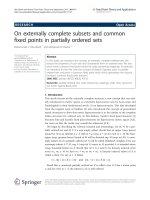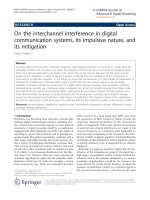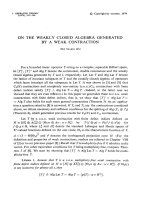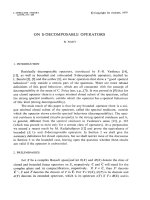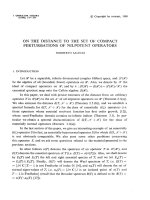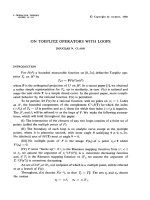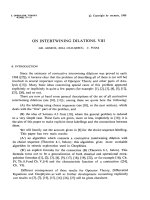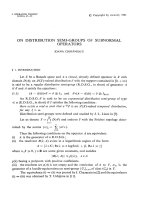Báo cáo toán học: "On small dense sets in Galois planes" pptx
Bạn đang xem bản rút gọn của tài liệu. Xem và tải ngay bản đầy đủ của tài liệu tại đây (148.64 KB, 13 trang )
On small dense sets in Galois planes
M. Giulietti
∗
Dipartimento di Matematica e Informatica
Universit`a di Perugia, Italy
Submitted: Jul 17, 2007; Accepted: Oct 31, 2007; Published: Nov 5, 2007
Mathematics Subject Classification: 51E20
Abstract
This paper deals with new infinite families of small dense sets in desarguesian
projective planes P G(2, q). A general construction of dense sets of size about 3q
2/3
is presented. Better results are obtained for specific values of q. In several cases, an
improvement on the best known upper bound on the size of the smallest dense set
in P G(2, q) is obtained.
1 Introduction
A dense set K in P G(2, q), the projective plane coordinatized over the finite field with q
elements F
q
, is a point-set whose secants cover P G(2, q), that is, any point of P G(2, q)
belongs to a line joining two distinct points of K. As well as being a natural geometrical
problem, the construction of small dense sets in P G(2, q) is relevant in other areas of
Combinatorics, as dense sets are related to covering codes, see Section 4, and defining
sets of block designs, see [2]; also, it has been recently pointed out in [13] that small dense
sets are connected to the degree/diameter problem in Graph Theory [17].
A straightforward counting argument shows that a trivial lower bound for the size k
of a dense set in P G(2, q) is k ≥
√
2q, see e.g. [19]. On the other hand, for q square there
is a nice example of a dense set of size 3
√
q, namely the union of three non-concurrent
lines of a subplane of P G(2, q) of order
√
q.
If q is not a square, however, the trivial lower bound is far away from the size of
the known examples. The existence of dense sets of size 5
√
qlogq was shown by means
of probabilistic methods, see [2, 14]. The smallest dense sets explicitly constructed so
far have size approximately cq
3
4
, with c a constant independent on q, see [1, 9, 18]; for
∗
This research was performed within the activity of GNSAGA of the Italian INDAM, with the financial
support of the Italian Ministry MIUR, project “Strutture geometriche, combinatorica e loro applicazioni”,
PRIN 2006-2007
the electronic journal of combinatorics 14 (2007), #R75 1
a survey see [2, Sections 3,4]. A construction by Davydov and
¨
Osterg˚ard [6, Thm. 3]
provides dense sets of size 2q/p + p, where p is the characteristic of F
q
; note that in the
special case where q = p
3
, p ≥ 17, the size of these dense sets is less than q
3
4
.
The main result of the present paper is a general explicit construction of dense sets
in P G(2, q) of size about 3q
2
3
, see Theorem 3.2. For large non-square q, q = p
3
, these are
the smallest explicitly constructed dense sets, whereas for q = p
3
the size is the same as
that of the example by Davydov and
¨
Osterg˚ard.
Using the same technique, smaller dense sets are provided for specific values of q, see
Theorem 3.7 and Corollary 3.8; in some cases they even provide an improvement on the
probabilistic bound, see Table 1.
Our constructions are essentially algebraic, and use linearized polynomials over the
finite field F
q
. For properties of linearized polynomials see [15, Chapter 3]. In the affine
line AG(1, q), take a subset A whose points are coordinatized by an additive subgroup
H of F
q
. Then H consists of the roots of a linearized polynomial L
H
(X). Let D
1
be the
union of two copies of A, embedded in two parallel lines in AG(2, q), namely the lines
with equation Y = 0 and Y = 1. The condition for a point P = (u, v) in AG(2, q) to
belong to some secant of D
1
is that the equation
L
H
(X) −vL
H
(Y ) + u = 0
has at least one solution in F
q
2
. This certainly occurs when the equation
L
H
(X) − vL
H
(Y ) = 0 has precisely q solutions in F
2
q
. (1)
This leads to the purely algebraic problem of determining the values of v for which
(1) holds. A complete solution is given in Section 2, see Proposition 2.5, by showing that
this occurs if and only if −v belongs to the set F
q
\M
H
, with
M
H
:=
L
H
1
(β
1
)
p
L
H
2
(β
2
)
p
. (2)
Here, H
1
and H
2
range over all subgroups of H of index p, that is | H | / | H
i
|= p, while
β
i
∈ H \ H
i
.
This shows that the points which are not covered by the secants of D
1
are the points
P = (u, v) with −v ∈ M
H
. The final step of our construction consists in adding a possibly
small number of points Q
1
, . . . , Q
t
to D
1
to obtain a dense set. For the general case, this
is done by just ensuring that the secants Q
i
Q
j
cover all points uncovered by the secants
of D
1
. For special cases, the above construction can give better results when more than
two copies of A are used.
It should be noted that sometimes in the literature dense sets are referred to as 1-
saturating sets as well.
the electronic journal of combinatorics 14 (2007), #R75 2
2 On the number of solutions of certain equations
over F
q
Let q = p
with p prime, and let H be an additive subgroup of F
q
of size p
s
with 2s ≤ .
Also, let
L
H
(X) =
h∈H
(X − h) ∈ F
q
[X]. (3)
Then L
H
is a linearized polynomial, that is, there exist β
0
, . . . , β
s
∈ F
q
such that L
H
(X) =
s
i=0
β
i
X
p
i
, see e.g. [15, Theorem 3.52].
For m ∈ F
q
, let
F
m
(X, Y ) = L
H
(X) −mL
H
(Y ). (4)
As the evaluation map (x, y) → F
m
(x, y) is an additive map from F
2
q
to F
q
, the equation
F
m
(X, Y ) = 0 has at least q solutions in F
2
q
. The aim of this section is to determine for
what m ∈ F
q
the number of solutions of F
m
(X, Y ) = 0 is precisely q, see Proposition 2.5.
Let F
p
denote the prime subfield of F
q
.
Lemma 2.1. If m ∈ F
p
, then the number of solutions in F
2
q
of the equation F
m
(X, Y ) = 0
is qp
s
.
Proof. Note that as m ∈ F
p
, mL
H
(Y ) = L
H
(mY ) holds. Then,
F
m
(X, Y ) = L
H
(X − mY ) =
h∈H
(X − mY − h).
As the equation X − mY − h = 0 has q solutions in F
2
q
, the claim follows.
Lemma 2.2. For any α ∈ F
q
,
X
p
− α
p−1
X =
i∈F
p
(X − iα) .
Proof. The assertion is trivial for α = 0. For α = 0, the claim follows from
i∈F
p
(X − iα) = α
p
i∈F
p
X
α
− i
= α
p
X
α
p
−
X
α
.
For any subgroup H
of H of size p
s−1
, pick an element β ∈ H \ H
and let
a
H
= L
H
(β)
p−1
. (5)
Note that a
H
does not depend on β. In fact,
h∈H
(X − h) =
i∈F
p
h
∈H
(X − h
− iβ) =
i∈F
p
L
H
(X − iβ) =
i∈F
p
(L
H
(X) −iL
H
(β)) ,
the electronic journal of combinatorics 14 (2007), #R75 3
and then, by Lemma 2.2,
L
H
(X) = L
H
(X)
p
− a
H
L
H
(X). (6)
Also, if a
H
1
= a
H
2
holds for two subgroups H
1
and H
2
of H, then by (6) it follows that
(L
H
1
(X) −L
H
2
(X))
p
= a
H
1
(L
H
1
(X) −L
H
2
(X));
this yields L
H
1
(X) = L
H
2
(X), whence H
1
= H
2
.
Let
M
H
:=
L
H
1
(β
1
)
p
L
H
2
(β
2
)
p
| H
1
, H
2
subgroups of H of size p
s−1
, β
i
∈ H \ H
i
. (7)
Note that for any λ ∈ F
p
,
L
H
1
(λβ
1
)
p
L
H
2
(β
2
)
p
= λ
L
H
1
(β
1
)
p
L
H
2
(β
2
)
p
,
whence λM
H
= M
H
holds provided that λ = 0. In particular,
−M
H
= M
H
. (8)
As H
1
= H
2
is allowed in (7), we also have that
F
∗
p
⊆ M
H
. (9)
Lemma 2.3. For any m ∈ M
H
, the equation F
m
(X, Y ) = 0 has at least pq solutions.
Proof. Fix H
1
, H
2
subgroups of H of size p
s−1
, β
1
∈ H \H
1
, and β
2
∈ H \H
2
, in such a
way that m =
L
H
1
(β
1
)
p
L
H
2
(β
2
)
p
. Let α =
L
H
1
(β
1
)
L
H
2
(β
2
)
. We claim that
F
m
(X, Y ) =
i∈F
p
(L
H
1
(X − iβ
1
) − αL
H
2
(Y )). (10)
In order to prove (10), note first that by Lemma 2.2
i∈F
p
(L
H
1
(X − iβ
1
) −αL
H
2
(Y )) = (L
H
1
(X) − αL
H
2
(Y ))
p
− a
H
1
(L
H
1
(X) − αL
H
2
(Y )).
Then, Equation (6) for H
= H
1
gives
i∈F
p
(L
H
1
(X − iβ
1
) − αL
H
2
(Y )) = L
H
(X) − α
p
L
H
2
(Y )
p
+ a
H
1
αL
H
2
(Y ).
As a
H
1
α = α
p
a
H
2
and m = α
p
, Equation (6) for H
= H
2
implies (10).
Now, the set of solutions of L
H
1
(X) − αL
H
2
(Y ) = 0 has size at least q, as it is the
nucleus of an F
p
-linear map from F
2
q
to F
q
. As the solutions of L
H
1
(X −iβ
1
)−αL
H
2
(Y ) = 0
are obtained from those of L
H
1
(X) −αL
H
2
(Y ) = 0 by the substitution X → X +iβ
1
, (10)
yields that F
m
(X, Y ) = 0 has at least pq solutions.
the electronic journal of combinatorics 14 (2007), #R75 4
Lemma 2.4. The size of M
H
is at most (p
s
− 1)
2
/(p −1).
Proof. Note that for each pair H
1
, H
2
of subgroups of H of size p
s−1
there are precisely
p − 1 elements in M
H
of type L
H
1
(β
1
)
p
/L
H
2
(β
2
)
p
. In fact,
L
H
1
(β
1
)
p
L
H
2
(β
2
)
p
p−1
=
a
p
H
1
a
p
H
2
.
As a
H
1
/a
H
2
only depends on H
1
and H
2
, the claim follows.
Now, the number of additive subgroups of H of size p
s−1
is (p
s
−1)/(p −1). Therefore
M
H
consists of at most
(p − 1) ·
p
s
− 1
p − 1
2
elements.
We are now in a position to prove the main result of the section.
Proposition 2.5. Let F
m
(X, Y ) be as in (4). The equation F
m
(X, Y ) = 0 has more than
q solutions if and only if either m ∈ M
H
or m = 0.
Proof. The claim for m = 0 follows from Lemma 2.1. Assume then that m = 0. Denote
ν
m
the number of solutions of F
m
(X, Y ) = 0. Also, denote F
∗
q
/F
∗
p
the factor group of the
multiplicative group of F
∗
q
by F
∗
p
. Consider the map
Φ : {(H
1
, H
2
) | H
1
, H
2
subgroups of H of size p
s−1
, H
1
= H
2
} → F
∗
q
/F
∗
p
(H
1
, H
2
) →
L
H
1
(β
1
)
p
L
H
2
(β
2
)
p
F
∗
p
,
with β
i
∈ H \H
i
. Note that Φ is well defined: for any β
i
, β
i
∈ H \H
i
, L
H
i
(β
i
)
p
= λL
H
i
(β
i
)
p
for some λ ∈ F
∗
p
, as
L
H
i
(β
i
)
p−1
= L
H
i
(β
i
)
p−1
= a
H
i
(see (5)).
For any µ ∈ M
H
, the size of Φ
−1
(µF
∗
p
) is related to ν
µ
. More precisely,
#Φ
−1
(µF
∗
p
) ≤
ν
µ
q
− 1
p −1
. (11)
In order to prove (11), write the unique factorization of F
µ
as follows:
F
µ
(X, Y ) = P
1
(X, Y ) ·P
2
(X, Y ) ·. . . ·P
r
(X, Y ).
Note that the multiplicity of each factor is 1. In fact, all the roots of L
H
(X) are sim-
ple, whence both the partial derivatives of F
µ
are non-zero constants. Assume that
Φ(H
1
, H
2
) = µF
∗
p
. Let α =
L
H
1
(β
1
)
L
H
2
(β
2
)
, and note that, by Equation (10),
F
µ
(X, Y ) = (L
H
1
(X) −αL
H
2
(Y ))
i∈F
∗
p
(L
H
1
(X − iβ
1
) − αL
H
2
(Y )) .
the electronic journal of combinatorics 14 (2007), #R75 5
Assume without loss of generality that P
1
(0, 0) = 0, so that P
1
(X, Y ) divides L
H
1
(X)−
αL
H
2
(Y ). We consider two actions of the group H on the set of irreducible factors of F
µ
.
For each h ∈ H, let (P
i
(X, Y ))
σ
1
(h)
= P
i
(X + h, Y ), and (P
i
(X, Y ))
σ
2
(h)
= P
i
(X, Y + h).
Assume that the stabilizer S
1
of P
1
(X, Y ) with respect to the action σ
1
has order p
t
.
Then the X-degree of P
1
(X, Y ) is at least p
t
. Note also that the orbit of P
1
(X, Y ) with
respect to σ
1
consists of p
s−t
factors, each of which has X-degree not smaller than p
t
. As
the X-degree of F
µ
is p
s
, we have that r = p
s−t
, and that the X-degree of P
1
(X, Y ) is
precisely p
t
. Taking into account that S
1
stabilizes P
1
(X, Y ), we have that for any h ∈ S
1
the polynomial X + h divides P
1
(X, Y ) −P
1
(0, Y ), whence
P
1
(X, Y ) −P
1
(0, Y ) = Q(Y )L
S
1
(X) (12)
for some polynomial Q. Now, let S
2
be the stabilizer of P
1
(X, Y ) under the action σ
2
,
and let p
t
be the order of S
2
. The above argument yields that r = p
s−t
, and therefore
t = t
. Also,
P
1
(X, Y ) −P
1
(X, 0) =
¯
Q(X)L
S
2
(Y ) (13)
for some polynomial
¯
Q. As the degrees of P
1
(X, Y ), L
S
1
(X), L
S
2
(Y ) are all equal to p
t
,
Equation (12) together with (13) imply that
P
1
(X, Y ) = γL
S
1
(X) −γ
L
S
2
(Y ),
for some γ
, γ ∈ F
q
. Therefore,
ν
µ
≥ qr = qp
s−t
.
As P
1
(X, Y ) divides L
H
1
(X) − αL
H
2
(Y ), and as H
1
is the stabilizer of the set of factors
of L
H
1
(X) − αL
H
2
(Y ) with respect to the action σ
1
, the group S
1
is a subgroup of H
1
.
The number of possibilities for subgroups H
1
is then less than or equal to the number of
subgroups of H of size p
s−1
containing S
1
, which is
p
s−t
−1
p−1
. Also, for a fixed H
1
, there is
at most one possibility for H
2
; in fact, Φ(H
1
, H
2
) = Φ(H
1
, H
2
) yields a
H
2
= a
H
2
, which
has already been noticed to imply H
2
= H
2
. Then
#Φ
−1
(µF
∗
p
) ≤
p
s−t
− 1
p −1
,
and therefore (11) is fulfilled.
Now, let M be the size of M
H
\F
p
. By counting the number of pairs (x, y) ∈ F
2
q
such
that L
H
(x) = 0 and L
H
(y) = 0, we obtain
(q −p
s
)
2
=
m∈F
∗
q
(ν
m
− p
2s
) .
Then, taking into account Lemma 2.1,
(q −p
s
)
2
≥ (p −1)(qp
s
− p
2s
) + (q −p − M)(q − p
2s
) − Mp
2s
+
µ∈M
H
\F
p
ν
µ
. (14)
the electronic journal of combinatorics 14 (2007), #R75 6
Note that if equality holds in (14), then the proposition is proved. Straightforward com-
putation yields that (14) is equivalent to
−M +
µ∈M
H
\F
p
ν
µ
q
≤ (p
s
− p)(p
s
− 1).
Let M
v
be the number of elements µ in M
H
\ F
p
such that ν
µ
= qp
v
. Then
−M +
µ∈M
H
\F
p
ν
µ
q
=
v
M
v
(p
v
− 1).
On the other hand, taking into account (11), we obtain that
v
M
v
(p
v
− 1) ≥
µF
∗
p
∈Im(Φ)
(p −1)
2
#Φ
−1
(µF
∗
p
) = (p − 1)
2
p
s
− 1
p − 1
p
s
− p
p − 1
= (p
s
−p)(p
s
−1).
Therefore equality must hold in (14), and the claim is proved.
3 Dense sets in P G(2, q)
Let q = p
. For an additive subgroup H of F
q
of size p
s
with 2s ≤ , let L
H
(X) be as in
(3), and M
H
be as in (7). For an element α ∈ F
q
, define
D
H,α
= {(L
H
(a) : α : 1) | a ∈ F
q
} ⊂ P G(2, q). (15)
As a corollary to Proposition 2.5, the following result is obtained.
Proposition 3.1. Let α
1
, α
2
be distinct elements in F
q
. Then a point P = (u : v : 1)
belongs to a line joining two points of D
H,α
1
∪D
H,α
2
provided that v /∈ (α
2
−α
1
)M
H
+ α
2
.
Proof. Assume that v /∈ (α
2
− α
1
)M
H
+ α
2
and that v = α
2
. Then by Proposition 2.5,
the equation
L
H
(X) +
v −α
2
α
1
− α
2
L
H
(Y ) = 0
has precisely q solutions, or, equivalently, the additive map
(x, y) → L
H
(x) +
v −α
2
α
1
− α
2
L
H
(y)
is surjective. This yields that there exists b, b
∈ F
q
such that
L
H
(b) +
v − α
2
α
1
− α
2
L
H
(b
) = u,
which is precisely the condition for the point P = (u : v : 1) to belong to the line joining
(L
H
(b
+ b) : α
1
: 1) ∈ D
H,α
1
and (L
H
(b) : α
2
: 1) ∈ D
H,α
2
.
If v = α
2
, then clearly P is collinear with two points in {(L
H
(a) : α
2
: 1) | a ∈ F
q
}.
the electronic journal of combinatorics 14 (2007), #R75 7
Theorem 3.2. Let q = p
, and let H be any additive subgroup of F
q
of size p
s
, with
2s ≤ . Let L
H
(X) be as in (3), and M
H
be as in (7). Then the set
D ={(L
H
(a) : 1 : 1), (L
H
(a) : 0 : 1) | a ∈ F
q
} ∪ {(0 : m : 1) | m ∈ M
H
}
∪ {(0 : 1 : 0), (1 : 0 : 0)}
is a dense set of size at most
2q
p
s
+
(p
s
− 1)
2
p − 1
+ 1.
Proof. Let P = (u : v : 1) be a point in P G(2, q). If v /∈ M
H
, then P belongs to the
line joining two points of D by Proposition 3.1, together with (8). If v ∈ M
H
, then P is
collinear with (0 : v : 1) ∈ D and (1 : 0 : 0) ∈ D. Clearly the points P = (u : v : 0) are
covered by D as they are collinear with (1 : 0 : 0) and (0 : 1 : 0). Then D is a dense set.
The set {L
H
(a) | a ∈ F
q
} is the image of an F
p
-linear map on F
q
∼
=
F
p
whose kernel
has dimension s, therefore its size is p
−s
. Note that the point (0 : 1 : 1) belongs to both
{(L
H
(a) : 1 : 1) | a ∈ F
q
} and {(0 : m : 1) | m ∈ M
H
} . Then the upper bound on the
size of D follows from Lemma 2.4.
The order of magnitude of the size of D of Theorem 3.2 is p
max{−s,2s−1}
. If s is chosen
as /3, then the size of D satisfies
#D ≤
2q
2
3
+ 1 +
q
2
3
−2q
1
3
+1
p−1
, if ≡ 0 (mod 3)
2
q
p
2
3
+ 1 +
p
2
(
q
p
)
2
3
−2p
(
q
p
)
1
3
+1
p−1
, if ≡ 1 (mod 3)
2
1
p
(qp)
2
3
+ 1 +
(qp)
2
3
−2(qp)
1
3
+1
p−1
, if ≡ 2 (mod 3)
.
Note that when s = 1, then M
H
coincides with F
∗
p
, and then the size of D is 2
q
p
+p. A
dense set of the same size and contained in three non-concurrent lines was constructed in
[6, Thm. 3]. It can be proved by straightforward computation that it is not projectively
equivalent to any dense set D constructed here.
In order to obtain a new upper bound on the size of the smallest dense set in PG(2, q), a
generalization of Theorem 3.2 is useful. Let A = {α
1
, . . . , α
k
} be any subset of k elements
of F
q
, and let
D(A) =
i=1, ,k
D
H,α
i
, M(A) =
i,j=1, ,k, i=j
(α
j
− α
i
)M
H
+ α
j
. (16)
Arguing as in the proof of Theorem 3.2, the following result can be easily obtained from
Proposition 3.1.
Theorem 3.3. The set
D(H, A) = D(A) ∪ {(0 : m : 1) | m ∈ M(A)}∪{(0 : 1 : 0), (1 : 0 : 0)}
is dense in PG(2, q).
the electronic journal of combinatorics 14 (2007), #R75 8
Computing the size of D(H, A) is difficult in the general case, as we do not have
enough information on the set M(A). However, by using some counting argument it is
possible to prove the existence of sets A for which a useful upper bound on the size of
M(A) can be established.
Proposition 3.4. For any v > 1, there exists a set A ⊂ F
q
of size v + 1 such that
#M(A) ≤
(#M
H
)
v
(q −1)
v−1
.
In order to prove Proposition 3.4, the following two lemmas are needed.
Lemma 3.5. Let E
1
and E
2
be any two subsets of F
∗
q
. Then there exists some α ∈ F
∗
q
such that
#(E
1
∩ αE
2
) ≤
#E
1
#E
2
q −1
.
Proof. For any β ∈ F
∗
q
, let E
(β)
be the subset of F
∗
q
consisting of those α for which β ∈ αE
2
.
Then
β∈F
∗
q
#E
(β)
= #{(α, β) ∈ (F
∗
q
)
2
| β ∈ αE
2
} =
α∈F
∗
q
#αE
2
= (q − 1)#E
2
. (17)
Note that the size of E
(β)
does not depend on β, since E
(β
)
=
β
β
E
(β)
. Therefore, (17)
yields that #E
(β)
= #E
2
for any β ∈ F
∗
q
. Then
#E
1
#E
2
=
β∈E
1
#E
(β)
= #{(α, β) ∈ (F
∗
q
)
2
| β ∈ E
1
∩ αE
2
} =
α∈F
∗
q
#(E
1
∩ αE
2
),
whence the claim follows.
Lemma 3.6. Let E be a subset of F
∗
q
, and let v be an integer greater than 1. Then there
exist α
1
= 1, α
2
, . . . , α
v
∈ F
∗
q
such that
#
i:=1, ,v
α
i
E ≤ (#E)
v
(q −1)
1−v
.
Proof. We prove the assertion by induction on v. For v = 2 the claim is just Lemma
3.5 for E
1
= E
2
= E. Assume that the assertion holds for any v
≤ v. Then there exist
α
1
= 1, α
2
, . . . , α
v−1
∈ F
∗
q
such that
#
i:=1, ,v−1
α
i
E ≤ (#E)
v−1
(q −1)
2−v
.
Lemma 3.5 for E
1
= ∩
i:=1, ,v−1
α
i
E, E
2
= E, yields the assertion.
the electronic journal of combinatorics 14 (2007), #R75 9
Proof of Proposition 3.4. According to Lemma 3.6, there exist α
1
= 1, α
2
, . . . , α
v
∈ F
∗
q
such that
#
i:=1, ,v
−α
i
M
H
≤ (#M
H
)
v
(q −1)
1−v
.
Let A = {0, α
1
, . . . , α
n
}, and let M(A) be as in (16). As
M(A) ⊆
i:=1, ,v
−α
i
M
H
,
the claim follows. ✷
As a straightforward corollary to Theorems 3.3 and 3.2, and Proposition 3.4, the
following result is then obtained.
Theorem 3.7. Let q = p
, with odd. Let H be any additive subgroup of F
q
of size p
s
,
with 2s + 1 = . Let L
H
(X) be as in (3), and M
H
be as in (7). Then for any integer
v ≥ 1 there exists a dense set D in P G(2, q) such that
#D ≤ (v + 1)p
s+1
+ (#M
H
)
v
(q −1)
1−v
+ 2. (18)
Corollary 3.8. Let q = p
2s+1
. Then there exists a dense set in PG(2, q) of size less than
or equal to
min
v=1, ,2s+1
(v + 1)p
s+1
+
(p
s
− 1)
2v
(p − 1)
v
(p
(2s+1)
− 1)
(v−1)
+ 2
.
Proof. The claim follows from Theorem 3.7, together with Lemma 2.4.
For several values of s and p, Corollary 3.8 improves the probabilistic bound on the
size of the smallest dense set in P G(2, q), namely, there exists some integer v such that
(v + 1)p
s+1
+
(p
s
− 1)
2v
(p − 1)
v
(p
(2s+1)
− 1)
(v−1)
+ 2 < 5
q log q, (19)
see Table 1.
the electronic journal of combinatorics 14 (2007), #R75 10
Table 1 - Values of p, s, v for which (19) holds
s p v
1 p ∈ [3, 79] 1
2 p ∈ [3, 53] 2
3 p ∈ [2, 83] 2
4 p ∈ [2, 53] 3
5 p = 2 4
5 p ∈ [3, 73] 3
6 p = 2 5
6 p ∈ [3, 47] 4
7 p = 2 6
7 p = 3 5
7 p ∈ [5, 61] 4
8 p = 2 7
8 p ∈ [3, 43] 5
9 p = 2 8
9 p = 3 6
9 p ∈ [5, 47] 5
10 p = 2 9
10 p = 3 7
10 p ∈ [5, 37] 6
11 p = 2 10
11 p = 3 7
11 p ∈ [5, 43] 6
12 p = 2 11
12 p = 3 8
12 p ∈ [5, 31] 7
13 p = 2 12
13 p = 3 8
13 p ∈ [5, 37] 7
14 p = 3 9
s p v
14 p ∈ [5, 29] 8
15 p = 3 10
15 p = 5 9
15 p ∈ [7, 31] 8
16 p = 3 10
16 p ∈ [5, 23] 9
17 p = 3 11
17 p = 5 10
17 p ∈ [7, 29] 9
18 p = 3 11
18 p ∈ [5, 23] 10
19 p = 3 12
19 p = 5 11
19 p ∈ [7, 23] 10
20 p = 3 13
20 p ∈ [5, 19] 11
21 p = 3 13
21 p = 5 12
21 p ∈ [7, 23] 11
22 p = 3 14
22 p ∈ [5, 19] 12
23 p = 3 15
23 p = 5 13
23 p ∈ [7, 19] 12
24 p = 3 15
24 p ∈ [5, 17] 13
25 p = 3 16
25 p ∈ [5, 7] 14
25 p ∈ [11, 17] 13
s p v
26 p = 3 16
26 p ∈ [5, 13] 14
27 p = 3 17
27 p ∈ [5, 7] 15
27 p ∈ [11, 17] 14
28 p = 3 18
28 p = 5 16
28 p ∈ [7, 13] 15
29 p = 3 18
29 p ∈ [5, 7] 16
29 p ∈ [11, 13] 15
30 p = 3 19
30 p = 5 17
30 p ∈ [7, 13] 16
31 p = 3 19
31 p ∈ [5, 7] 17
31 p ∈ [11, 13] 16
32 p = 3 20
32 p = 5 18
32 p ∈ [7, 11] 17
33 p = 3 21
33 p ∈ [5, 7] 18
33 p = 11 17
34 p = 3 21
34 p = 5 19
34 p ∈ [7, 11] 18
35 p = 3 22
35 p ∈ [5, 7] 19
35 p = 11 18
s p v
36 p = 3 22
36 p = 5 20
36 p = 7 19
37 p = 3 23
37 p ∈ [5, 7] 20
38 p = 3 24
38 p = 5 21
38 p = 7 20
39 p = 3 24
39 p ∈ [5, 7] 21
40 p = 3 25
40 p = 5 22
40 p = 7 21
41 p = 3 26
41 p = 5 23
41 p = 7 22
42 p = 3 26
42 p = 5 23
42 p = 7 22
43 p = 5 24
43 p = 7 23
44 p = 5 24
44 p = 7 23
45 p = 5 25
45 p = 7 24
46 p = 5 25
47 p = 5 26
48 p = 5 26
49 p = 5 27
In order to produce concrete examples of small dense sets of type D = D(H, A), with
= 2s + 1, for which the strict inequality holds in (18), a computer search has been
carried out. The sizes of the resulting dense sets are described in Table 2 below. Taking
into account that for q ≤ 859 dense sets of size smaller than 4p
s+
1
2
have been obtained by
computer in [7, 8], only values of q > 859 are considered in Table 2.
the electronic journal of combinatorics 14 (2007), #R75 11
Table 2 - Sizes of some dense sets in P G(2, q) of type D(H, A) with = 2s + 1
q #A #D(H, A) q #A #D(H, A)
2
11
4 258 5
9
3 9609
2
13
4 532 7
5
2 1030
2
15
4 1162 7
7
3 7205
2
17
5 2576 7
9
3 50947
2
19
5 5210 11
5
2 3994
3
7
3 245 11
7
3 43947
3
9
3 764 13
5
2 6592
3
11
3 2771 13
7
3 85712
3
13
4 8788 17
5
2 14740
5
5
2 376 17
7
3 250599
5
7
3 1877 19
5
2 20578
4 Applications to covering codes
A code with covering radius R is a code such that every word is at distance at most
R from a codeword. For linear covering codes over F
q
, it is relevant to investigate the
so-called length function l(m, R)
q
, that is the minimum length of a linear code over F
q
with covering radius R and codimension m, see the monography [3]. It is well known that
the minimum size of a dense set in P G(2, q) coincides with l(3, 2)
q
, see e.g. [4]. From our
Corollary 3.8, we then obtain the following result.
Theorem 4.1. Let q = p
, with = 2s + 1. Then
l(3, 2)
q
≤ min
v=1, ,2s+1
(v + 1)p
s+1
+
(p
s
− 1)
2v
(p −1)
v
(p
(2s+1)
− 1)
(v−1)
+ 2
.
It should also be noted that upper bounds on l(m, 2)
q
, m ≥ 5 odd, can be obtained
from small dense sets. In fact, from a dense set of size k in P G(2, q) it can be constructed
a linear code over F
q
with covering radius 2, codimension 3 + 2m, and length about q
m
k,
see [5, Theorem 1].
References
[1] U. Bartocci, k-insiemi densi in piani di Galois, Boll. Un. Mat. Ital. D 2 (1983),
71–77.
[2] E. Boros, T. Sz˝onyi, and K. Tichler On defining sets for projective planes, Discrete
Math. 303 (2005), 17–31.
[3] G.D. Cohen, I. Honkala, S. Litsyn, and A.C. Lobstein, “Covering Codes”. Amster-
dam, The Netherlands: Elsevier, 1997.
[4] A.A. Davydov, Constructions and Families of Covering Codes and Saturated Sets of
Points in Projective Geometry, IEEE Trans. Inform. Theory 41 (1995), 2071–2080.
the electronic journal of combinatorics 14 (2007), #R75 12
[5] A.A. Davydov, Constructions and Families of Nonbinary Linear Codes with Covering
Radius 2, IEEE Trans. Inform. Theory 45 (1999), 1679–1686.
[6] A.A. Davydov and P.R.J.
¨
Osterg˚ard, On saturating sets in small projective geome-
tries, European J. Combin. 21 (2000), 563–570.
[7] A.A. Davydov, S. Marcugini and F. Pambianco, On saturating sets in projective
spaces, J. Combin. Theory Ser. A 103 (2003), 1–15.
[8] A.A. Davydov, S. Marcugini and F. Pambianco, Linear Codes With Covering Radius
2, 3 and Saturating Sets in Projective Geometry, IEEE Trans. Inform. Theory 50
(2004), 537–541.
[9] M. Giulietti and F. Torres, On dense sets related to plane algebraic curves, Ars
Combinatoria 72 (2004), 33–40.
[10] B.D. Gray, N. Hamilton, C.M. O’Keefe, On the size of the smallest defining set of
P G(2, q), Bull. Inst. Combin. Appl. 21 (1997), 91–94.
[11] K. Gray, Defining sets of single-transposition-free designs, Utilitas Mathematica 38
(1990), 97–103.
[12] K. Gray, On the minimum number of blocks defining a design, Bull. Austral. Math.
Soc. 41 (1990), 97–112.
[13] G. Kiss, I. Kov´acs, K. Kutnar, J. Ruff and P.
ˇ
Sparl, A note on a geometric construc-
tion of large Cayley graphs of given degree and diameter, submitted.
[14] S.J. Kov´acs, Small saturated sets in finite projective planes Rend. Mat. 12 (1992),
157–164.
[15] R. Lidl and H. Niederreiter, Finite Fields, Enc. of Math. 20, Addison-Wesley, Read-
ing, 1983.
[16] L. Lunelli and M. Sce, Considerazioni aritmetiche e risultati sperimentali sui {K; n}
q
archi, Ist. Lombardo Accad. Sci. Rend. A 98 (1964), 3–52.
[17] M. Miller and J.
ˇ
Sir´aˇn, Moore graphs and beyond: A survey of the degree/diameter
problem, Electron. J. Comb., Dynamical Surveys DS14.
[18] T. Sz˝onyi, Complete arcs in finite projective geometries, Ph. D. Thesis, Univ. L.
E¨otv¨os, Budapest, 1984.
[19] E. Ughi, Saturated configurations of points in projective Galois spaces, European J.
Combin. 8 (1987), 325–334.
the electronic journal of combinatorics 14 (2007), #R75 13
